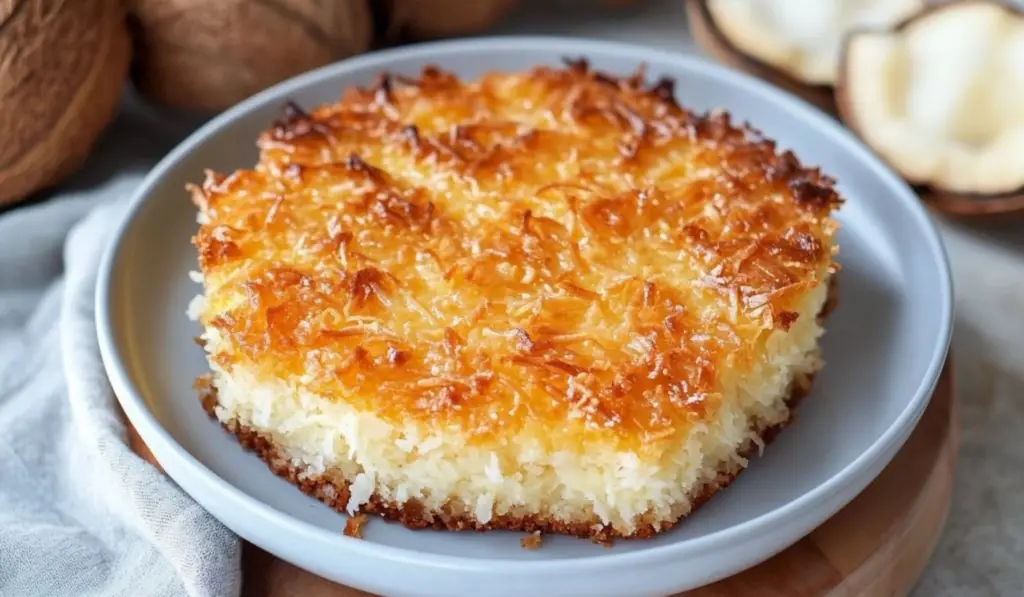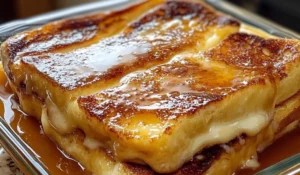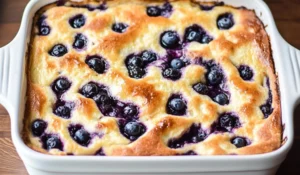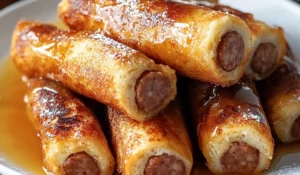Bibingka, a classic Filipino dessert, is more than just a cake—it’s a celebration of the rich culture, history, and flavors of the Philippines. Known for its soft, slightly chewy texture and sweet coconut flavor, bibingka has been enjoyed for generations. Traditionally baked in clay pots lined with banana leaves, this coconut cake has found its way into modern kitchens, retaining its charm while being adapted for the convenience of today’s home bakers. Whether it’s enjoyed during Christmas or any special occasion, bibingka continues to be a beloved treat that brings people together.
PrintThe Irresistible Charm of Bibingka: A Filipino Coconut Cake Delight
Bibingka, a classic Filipino dessert, is more than just a cake—it’s a celebration of the rich culture, history, and flavors of the Philippines. Known for its soft, slightly chewy texture and sweet coconut flavor, bibingka has been enjoyed for generations. Traditionally baked in clay pots lined with banana leaves, this coconut cake has found its way into modern kitchens, retaining its charm while being adapted for the convenience of today’s home bakers. Whether it’s enjoyed during Christmas or any special occasion, bibingka continues to be a beloved treat that brings people together.
- Prep Time: 15 minutes
- Cook Time: 1 hour
- Total Time: 1 hour 15 minutes
- Yield: 20 servings
- Category: Dessert
- Method: Baking
- Cuisine: Filipino
- Diet: Vegetarian
Ingredients
- Cream Cheese (8 oz): The addition of cream cheese in bibingka provides a subtle tangy flavor that balances the sweetness of the cake. It also contributes to the richness and smooth texture. The cream cheese helps to create a creamy batter, which is essential for achieving the right mouthfeel in the finished cake.
- Granulated Sugar (2 cups): Sugar is the primary sweetener in this recipe. Bibingka needs to be sweet, but not overwhelmingly so. The sugar, when combined with the other ingredients, enhances the natural sweetness of the coconut and the cream cheese, giving the cake a balanced flavor.
- Eggs (3): Eggs bind the ingredients together and provide structure to the cake. They also help the bibingka rise and achieve the slightly spongy texture that is characteristic of the dish.
- Sweet Rice Flour (3 ½ cups): The star ingredient in bibingka is sweet rice flour, which gives the cake its unique chewy texture. Sweet rice flour is made from glutinous rice and is used in many Filipino rice cakes. It absorbs liquid well, helping to create a moist, tender cake.
- Baking Powder (1 tbsp): Baking powder helps the bibingka rise during baking. This ingredient is essential to ensuring that the cake is light and fluffy, as opposed to dense and heavy.
- Melted Butter (½ cup): Butter adds moisture and richness to the cake, while also contributing to the flavor. It helps create a tender crumb and gives the bibingka its soft, melt-in-your-mouth texture.
- Vanilla (1 tbsp): Vanilla is used to enhance the overall flavor of the cake. It adds a warm, aromatic note that complements the coconut and cream cheese perfectly.
- Cream of Coconut (15 oz can): Cream of coconut is the defining ingredient in bibingka. It gives the cake its tropical flavor, rich creaminess, and slightly sweet undertone. Unlike coconut milk, which is thinner, cream of coconut is much thicker and sweeter, making it perfect for baking.
- Milk (1 cup): Milk helps to thin out the batter and adds moisture. It works in combination with the cream of coconut to give the bibingka its characteristic smooth texture.
- Crushed Pineapple (8 oz can): Pineapple adds a subtle, fruity sweetness that contrasts beautifully with the creaminess of the coconut and cream cheese. It also helps keep the cake moist and tender.
For the Topping
- Brown Sugar (¼ cup): Brown sugar is sprinkled on top of the bibingka before baking. It melts and caramelizes during the cooking process, forming a deliciously sweet and slightly crispy top.
- Granulated Sugar (2 tbsp): A touch of granulated sugar is mixed with the brown sugar to add a little extra sweetness and help with the caramelization process.
Instructions
1. Preheat the Oven and Prepare the Baking Pan
Begin by preheating your oven to 350°F (175°C). Grease a 13×9-inch baking pan to prevent the bibingka from sticking. You can also line the pan with parchment paper for extra protection.
2. Cream the Cream Cheese and Sugar
In a large mixing bowl, cream together the softened cream cheese and granulated sugar. Use a hand mixer or stand mixer on medium speed until the mixture is smooth and creamy. This will help to create a light, fluffy batter that bakes into the perfect cake.
3. Add the Eggs
Add the eggs one at a time, mixing well after each addition. The eggs help to bind the ingredients and give the bibingka its structure. Be sure to mix thoroughly so that the eggs are fully incorporated into the cream cheese and sugar mixture.
4. Mix in the Dry Ingredients
Sift the sweet rice flour and baking powder into the batter. Stir until the mixture is smooth and free of lumps. The batter will be thick, but it should still be pourable.
5. Add the Wet Ingredients
Mix in the melted butter, vanilla extract, cream of coconut, and milk. Stir until everything is well combined. The batter should have a smooth consistency, and it should be slightly thicker than regular cake batter.
6. Incorporate the Pineapple
Add the crushed pineapple to the batter and stir it in gently. The pineapple will add moisture and a touch of tartness to balance the sweetness of the coconut and cream cheese.
7. Pour the Batter into the Pan
Pour the prepared batter into the greased baking pan. Use a spatula to smooth the top and ensure that the batter is evenly distributed.
8. Add the Topping
Sprinkle the brown sugar and granulated sugar evenly over the top of the batter. This will create a sweet, caramelized crust as the bibingka bakes.
9. Bake the Bibingka
Place the pan in the preheated oven and bake for 1 hour, or until a toothpick inserted in the center comes out clean. The top should be golden brown, and the edges should begin to pull away from the pan.
10. Cool and Serve
Allow the bibingka to cool completely in the pan before cutting it into squares. This allows the cake to set and makes it easier to slice. Once cooled, serve the bibingka on its own or with a dollop of whipped cream for added indulgence.
Notes
- Use High-Quality Ingredients: For the best flavor, use fresh cream of coconut and high-quality sweet rice flour. The better the ingredients, the better the cake will turn out.
- Customize the Toppings: While the traditional topping of brown sugar and granulated sugar is delicious, feel free to get creative. You can add shredded coconut, salted egg slices, or even grated cheese on top for an extra burst of flavor.
- Check for Doneness Early: Since ovens vary, it’s a good idea to check the bibingka around the 50-minute mark. If it’s already golden brown and a toothpick comes out clean, it’s ready to come out of the oven.
- Banana Leaves for Extra Flavor: If you want to take your bibingka to the next level, line your baking pan with banana leaves before pouring in the batter. The leaves will infuse the cake with a subtle, aromatic flavor that is truly authentic.
The appeal of bibingka lies not only in its taste but in its ability to transport you to a warm, tropical place with every bite. The comforting aroma of freshly baked coconut, mixed with the slight sweetness of brown sugar and the subtle tang of cream cheese, makes bibingka irresistible. In this article, we’ll dive deep into the history of bibingka, the process of making this delightful cake, and how to ensure your own version comes out perfect every time.
The Origins of Bibingka: A Filipino Tradition
Bibingka has deep roots in Filipino culture. The name “bibingka” refers to a wide variety of rice cakes found throughout the Philippines, with each region having its own interpretation of the dish. While there are many different versions of bibingka, the one most associated with Filipino Christmas celebrations is a soft, spongy cake made with sweet rice flour, cream of coconut, and a mix of sugar and eggs.
The tradition of baking bibingka dates back to pre-colonial times. In ancient Filipino culture, rice was a staple food, and the use of rice flour in desserts became a natural progression. Bibingka was originally cooked in clay pots, often with banana leaves at the base, which gave it a unique flavor and aroma. The cake’s slightly chewy texture comes from the sweet rice flour, which has a high starch content, making it different from typical Western cakes.
Today, bibingka is still an integral part of Filipino Christmas celebrations. During the “Simbang Gabi” (Night Mass), people flock to street vendors selling freshly baked bibingka, often served with a side of salted eggs and grated coconut. This cake has become a symbol of Filipino hospitality and warmth, with its comforting taste and cultural significance.
Understanding the Ingredients of Bibingka
The key to making a delicious bibingka lies in the ingredients. Each one plays an important role in creating the perfect flavor and texture. Let’s break down the ingredients used in this recipe and understand why they are essential to achieving the classic bibingka taste.
- Cream Cheese (8 oz): The addition of cream cheese in bibingka provides a subtle tangy flavor that balances the sweetness of the cake. It also contributes to the richness and smooth texture. The cream cheese helps to create a creamy batter, which is essential for achieving the right mouthfeel in the finished cake.
- Granulated Sugar (2 cups): Sugar is the primary sweetener in this recipe. Bibingka needs to be sweet, but not overwhelmingly so. The sugar, when combined with the other ingredients, enhances the natural sweetness of the coconut and the cream cheese, giving the cake a balanced flavor.
- Eggs (3): Eggs bind the ingredients together and provide structure to the cake. They also help the bibingka rise and achieve the slightly spongy texture that is characteristic of the dish.
- Sweet Rice Flour (3 ½ cups): The star ingredient in bibingka is sweet rice flour, which gives the cake its unique chewy texture. Sweet rice flour is made from glutinous rice and is used in many Filipino rice cakes. It absorbs liquid well, helping to create a moist, tender cake.
- Baking Powder (1 tbsp): Baking powder helps the bibingka rise during baking. This ingredient is essential to ensuring that the cake is light and fluffy, as opposed to dense and heavy.
- Melted Butter (½ cup): Butter adds moisture and richness to the cake, while also contributing to the flavor. It helps create a tender crumb and gives the bibingka its soft, melt-in-your-mouth texture.
- Vanilla (1 tbsp): Vanilla is used to enhance the overall flavor of the cake. It adds a warm, aromatic note that complements the coconut and cream cheese perfectly.
- Cream of Coconut (15 oz can): Cream of coconut is the defining ingredient in bibingka. It gives the cake its tropical flavor, rich creaminess, and slightly sweet undertone. Unlike coconut milk, which is thinner, cream of coconut is much thicker and sweeter, making it perfect for baking.
- Milk (1 cup): Milk helps to thin out the batter and adds moisture. It works in combination with the cream of coconut to give the bibingka its characteristic smooth texture.
- Crushed Pineapple (8 oz can): Pineapple adds a subtle, fruity sweetness that contrasts beautifully with the creaminess of the coconut and cream cheese. It also helps keep the cake moist and tender.
For the Topping
- Brown Sugar (¼ cup): Brown sugar is sprinkled on top of the bibingka before baking. It melts and caramelizes during the cooking process, forming a deliciously sweet and slightly crispy top.
- Granulated Sugar (2 tbsp): A touch of granulated sugar is mixed with the brown sugar to add a little extra sweetness and help with the caramelization process.
Step-by-Step Instructions for Perfect Bibingka
Now that we’ve explored the ingredients, let’s dive into the process of making this delicious coconut cake. Follow these detailed instructions, and you’ll have a perfectly baked bibingka in no time.
1. Preheat the Oven and Prepare the Baking Pan
Begin by preheating your oven to 350°F (175°C). Grease a 13×9-inch baking pan to prevent the bibingka from sticking. You can also line the pan with parchment paper for extra protection.
2. Cream the Cream Cheese and Sugar
In a large mixing bowl, cream together the softened cream cheese and granulated sugar. Use a hand mixer or stand mixer on medium speed until the mixture is smooth and creamy. This will help to create a light, fluffy batter that bakes into the perfect cake.
3. Add the Eggs
Add the eggs one at a time, mixing well after each addition. The eggs help to bind the ingredients and give the bibingka its structure. Be sure to mix thoroughly so that the eggs are fully incorporated into the cream cheese and sugar mixture.
4. Mix in the Dry Ingredients
Sift the sweet rice flour and baking powder into the batter. Stir until the mixture is smooth and free of lumps. The batter will be thick, but it should still be pourable.
5. Add the Wet Ingredients
Mix in the melted butter, vanilla extract, cream of coconut, and milk. Stir until everything is well combined. The batter should have a smooth consistency, and it should be slightly thicker than regular cake batter.
6. Incorporate the Pineapple
Add the crushed pineapple to the batter and stir it in gently. The pineapple will add moisture and a touch of tartness to balance the sweetness of the coconut and cream cheese.
7. Pour the Batter into the Pan
Pour the prepared batter into the greased baking pan. Use a spatula to smooth the top and ensure that the batter is evenly distributed.
8. Add the Topping
Sprinkle the brown sugar and granulated sugar evenly over the top of the batter. This will create a sweet, caramelized crust as the bibingka bakes.
9. Bake the Bibingka
Place the pan in the preheated oven and bake for 1 hour, or until a toothpick inserted in the center comes out clean. The top should be golden brown, and the edges should begin to pull away from the pan.
10. Cool and Serve
Allow the bibingka to cool completely in the pan before cutting it into squares. This allows the cake to set and makes it easier to slice. Once cooled, serve the bibingka on its own or with a dollop of whipped cream for added indulgence.
Tips for Making the Best Bibingka
- Use High-Quality Ingredients: For the best flavor, use fresh cream of coconut and high-quality sweet rice flour. The better the ingredients, the better the cake will turn out.
- Customize the Toppings: While the traditional topping of brown sugar and granulated sugar is delicious, feel free to get creative. You can add shredded coconut, salted egg slices, or even grated cheese on top for an extra burst of flavor.
- Check for Doneness Early: Since ovens vary, it’s a good idea to check the bibingka around the 50-minute mark. If it’s already golden brown and a toothpick comes out clean, it’s ready to come out of the oven.
- Banana Leaves for Extra Flavor: If you want to take your bibingka to the next level, line your baking pan with banana leaves before pouring in the batter. The leaves will infuse the cake with a subtle, aromatic flavor that is truly authentic.

Conclusion
Bibingka is a beloved Filipino dessert that combines simplicity with rich, tropical flavors. Whether it’s the holidays, a family gathering, or just a sweet treat to enjoy at any time, bibingka is the perfect dessert to bring people together. Its moist texture, sweet coconut flavor, and rich, creamy layers make it a standout dish that will surely leave a lasting impression.
By following this recipe and tips, you can create a bibingka that tastes just like the ones sold by street vendors in the Philippines. So, why not try making this delightful Filipino coconut cake at home? With a few simple ingredients and a little bit of patience, you can enjoy a slice of Filipino tradition anytime you wish.




